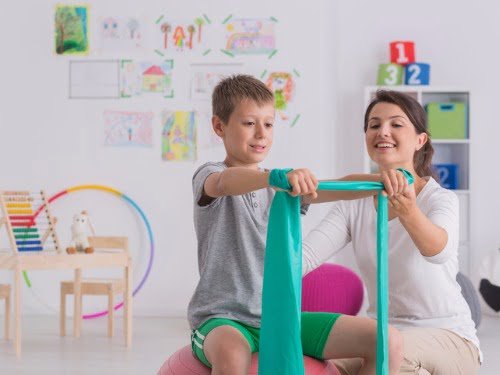
Physical therapists (PTs) develop treatment programs to promote the ability to move, reduce pain, restore function, and prevent disability. Children with CMT who are struggling with the activities of daily living may greatly benefit from a physical therapy program.
But is physical therapy right for your child?
Dr. Sharon DeMuth, Adjunct Associate Professor of Clinical Physical Therapy at the University of Southern California, Los Angeles, shares some helpful tips concerning physical therapies for children with CMT.
There should be collaboration among all therapists working with the child.
It’s important to note that depending on the child’s age, other therapies will overlap with a physical therapy program, such as Occupational Therapy (OT). Be sure to coordinate all efforts with your healthcare providers for the best outcome for your child.
Kids grow and change rapidly.
With a chronic, degenerative disease like CMT, the progression of symptoms need to be monitored on a regular basis. Developing a strategy with your healthcare providers that aligns with the child’s current condition will help determine when PT is appropriate.
Find healthcare professionals who deal with kids on a regular basis.
HCPs who are comfortable with kids will encourage their participation in a PT program. Dr. DeMuth says to “take yourself out of the picture of being the therapy enforcer.” Kids are more likely to listen to adults other than their parents.
Take advantage of their favorite activity.
It can be an enormous motivator to encourage participation in therapies that allow them to take part in their favorite activity. Or that by using a specific therapeutic device, they can keep enjoying the activities they love the most.
You have to meet your child where they are.
Always point out the capabilities they do have. Encourage your child to be their own advocate for their health. They will feel empowered by taking charge of their own health and wellbeing.
Address emotional difficulties with therapy by engaging in conversation.
It’s important to keep a dialogue with your child to understand where resistance to therapy is coming from. What has changed? What is worrying them? Role playing is another great way to get them to share their feelings. Ask questions like what would they say if someone asks why they wear braces? Be sure to tell the therapist of any changes so they can restructure therapy to meet your child’s emotional needs.
There should always be a two-way conversation between patient (parent) and therapist.
It’s okay to ask your therapist to explain different therapies and to suggest sources to read about more options. If your current therapist is reluctant to discuss treatments or treatment options, look for someone else.
Make sure you and your child take breaks from therapy.
All of us need breaks from time to time to mentally recharge. Parents need the break from their child’s therapy schedule as much as their kids do. Dr. DeMuth points out that research shows intense, short bursts of therapy might be more effective than going three times a week for years. If there is a period of rapid growth, intervention might be indicated. If your child appears stable and not regressing, take it easy. You can always revisit therapy if a problem arises or if your child experiences a growth spurt.





0 Comments